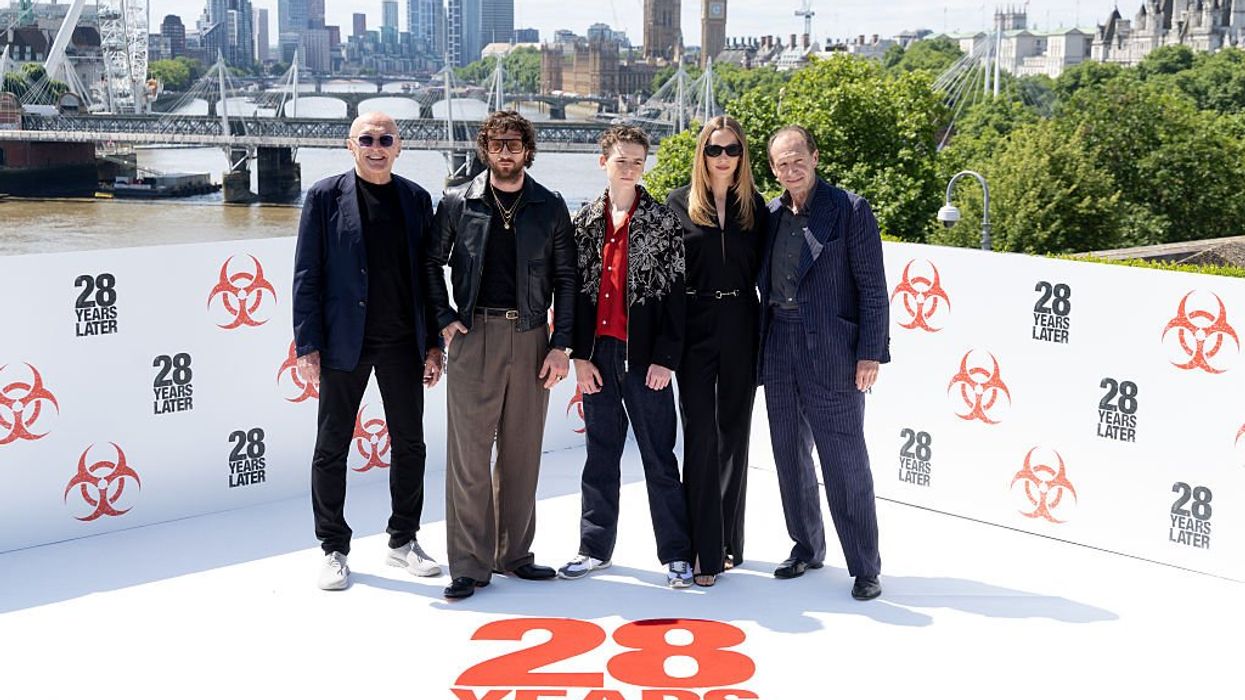
Tim P. Whitby/Getty Images

The long-awaited sequel offers vivid gore and surprising tenderness, but fails to cohere.
Britain has been reduced to a dysfunctional, plague-ridden landmass where hideous creatures consumed by rage roam in search of prey. Small, isolated communities are struggling to survive with scarce resources and little hope for rejuvenation, leaving them to cling to quaint remnants of a bygone era.
It's good thing we have Danny Boyle's long-awaited follow-up to 2007's "28 Weeks Later" to distract us.
Boyle’s film, whether intended or not, unapologetically embraces British culture, drawing on Shakespeare and Kipling.
Completing the trilogy that began in 2002 with "28 Days Later," "28 Years Later" picks up, unsurprisingly, 28 years after the initial rage virus outbreak.
Britain is currently in a military-imposed lockdown, shut off from the rest of the world. A group of survivors are living on a remote island not far from the mainland. In many respects they are totally isolated — not just geographically but culturally. There is no electricity. No internet. Men work with their hands, while children sing Anglican hymns at school.
The accordion provides entertainment in the evening, helping the revelers forget the terror lurking nearby. For these contemporary Pilgrims, the tidal island is linked to the mainland by a fortified causeway.
Among them is Jamie (Aaron Taylor-Johnson), who decides to take his 12-year-old son, Spike, to the mainland to kill his first infected — a coming-of-age ritual among the island’s inhabitants. During this hunting trip, we witness the full mutated horror of the virus. Decaying skeletal creatures lurch forward while fat ones writhe across the ground like Jabba the Hutt with eczema.
These early scenes feature some stunning gore — cinematographer Anthony Dod Mantle beautifully captures the moment of impact with a time-freezing jolt that is reminiscent of the bullet effect from "The Matrix."
Then Boyle makes a distinct tonal shift toward sentimentality, transforming the narrative from a father-son tale to an emotional mother-son one. As Spike is inducted into the zombie-slaying hall of fame, his mother, Isla (Jodie Comer), remains bedridden due to an undiagnosed illness.
Here the movie turns into a quest. Spike takes his sickly mother away from the relative safety of the island to find the infamous Dr. Ian Kelson (Ralph Fiennes), who might be able to treat her.
There are some genuinely interesting ideas here. The issue is that it seems like the movie has been divided into multiple parts, each with a different tone. Numerous scenes conclude abruptly, often resulting in confusion or a lackluster climax. Characters enter and exit the story much like a sitcom, and despite dramatic introductions, they contribute little to the storyline.
The doctor is depicted as an enigmatic and influential presence; however, Fiennes’ talents are wasted in this role. When he eventually appears on screen, he is covered in iodine, spouting pseudo-intellectual nonsense and shooting tranquilizer darts at monsters. He spends his time creating massive memento mori towers from bones and skulls — of which there is no shortage. In fact, more than one living character will end up in his art project before movie's end.
At moments, this story compels us to contemplate our own mortality. At other moments, it treats us to the spectacle of a spray-tanned Voldemort neutralizing a ripped zombie Neanderthal sporting a distractingly large Hampton Wick.
"28 Years Later" is strongest in its depiction of Spike's coming of age. You see how the painful lessons and mistakes turn him from an innocent boy into a responsible adult. That haunting sense of loss that comes with leaving behind what you were and the terrifying realization of what you need to be to survive. Boyle really nails that feeling. It's just a shame that it gets overshadowed by a confusing plot.
There is a lot about this film that will confuse Americans — not least the regional accents. Unfortunately, trying to understand what a Geordie is saying is like asking if a cat can grasp the concept of Sweden. Contrary to popular mythology, not all of us Brits sound like we’ve stepped off the set of a Richard Curtis movie or live in a castle.
Boyle’s film, whether intended or not, unapologetically embraces British culture, drawing on Shakespeare and Kipling, while exploring themes of social cohesion, identity, and in-group preference — elements intrinsic to the survival horror genre. The cast is entirely white. In a world where entertainment has been ideologically captured by identity politics, it's a welcome and refreshing change.
Possibly the best thing is the music. It's similar to the score featured in "28 Days Later," which includes haunting contributions from Canadian ambient post-rock band Godspeed You! Black Emperor and Scottish trio Young Fathers. The suspense, paranoia, and carnage are heightened by a thumping, deep bass rumble.
While entertaining and at times poignant, "28 Years Later" is a movie that fascinates as much as it frustrates due to undeveloped characters and a nonlinear narrative. Let’s hope they iron out these problems in the sequel, "The Bone Temple," which is set for release next January.
At the helm is Nia DaCosta, infamous for directing "The Marvels," a movie that single-handedly ushered in Hollywood's anti-woke backlash. I’m already terrified.
Noel Yaxley